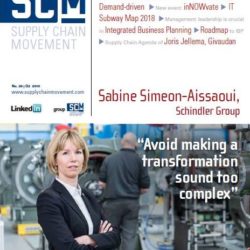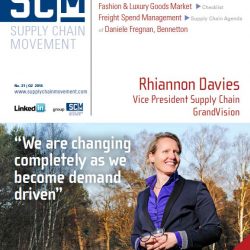Supply Chain Movement issue 29 – From S&OP to IBP

Contents Supply Chain Movement 29 – 2018 Q2
Date of appearance: May 25th, 2018
6 | News & Background
8 | Snapshots
10 | IT Subway Map 2018
12 | Profile Sabine Simeon-Aissaoui, Schindler Group:
“Avoid making a transformation sound too complex”
Talented and ambitious, Sabine Simeon-Aissaoui was in full flight when an unsuccessful project, which she initiated in China, knocked her confidence. It gave her time to regroup, think, and come back with renewed energy and determination. After a short spell working for a supplier in Singapore she returned to the Swiss Schindler Group in 2014 and transformed its European Supply Chain. This led to her receiving the APICS Award for Excellence – supply chain leader, an award that honors extraordinary team and organizational leadership, mentoring of fellow professionals and contributions that advance the supply chain industry as a whole. With an operational mindset Simeon-Aissaoui prefers ‘to do’ than ‘to talk’ but enthusiastically shares her experiences in order to inspire others.
18 | Key boardroom conversations
20 | Management: Leadership crucial in Integrated Business Planning
A growing number of companies that have implemented Sales & Operations Planning (S&OP) are now taking the next step towards Integrated Business Planning (IBP). This means that the likes of the Finance and Strategy departments are joining their Sales, Marketing and Production colleagues at the meetings, and the discussion is now also about money rather than just volumes. Experience has shown that this step can be harder than many people think. “It’s impossible to achieve the most advanced stage of IBP maturity without leadership.”
27 | Checklist S&OP mindset
28 | The DNA of S&OP software
31 | Facts & Figures
33 | Roadmap S&OP to IBP
34 | Virtual Roundtable: Becoming Demand-driven
A new approach to production planning, demand-driven material requirements planning (DDMRP), is increasingly being applied as an alternative to the more traditional manufacturing resources planning. To find out more about how and why organizations are becoming demand driven, Supply Chain Movement organized a ‘virtual roundtable’ and asked several industry professionals for their responses to three statements.
37 | Supply Chain Method: Checklist Supply Chain Segmentation
The increasing fragmentation of today’s markets implies that supply chains need to handle very different products and serve customers with different needs. Nevertheless, a lot of companies still work based on the ‘one-size-fits-all’ principle. In reality, several different customer value propositions are often needed, each requiring a different supply chain strategy. Supply chain segmentation can provide the answer… but when should you segment your supply chain, and how many supply chains do you need? Supply Chain Movement and Chainalytics, a global provider of supply chain consulting and market intelligence, have created this supply chain segmentation checklist to help you find out whether one supply chain is enough in your case.
38 | inNOWvate Supply Chain Event
41 | Supply Chain Method: Checklist Live Vehicle Tracking
Delivery reliability plays a key role in improving customer service. In the context of containerized cargo, demurrage and detention are two crucial cost items that can become a huge problem for customers if they do not control their shipments carefully. Visibility of transport execution can help shippers to take corrective action in the case of any problems and inform their customers about any delays. Live vehicle tracking solutions provide shippers and carriers with real-time visibility into the locations of vehicles and drivers for optimum control.
43 | Tools & Technology: Total solution for transport management
Alpega, a logistics software supplier and the owner of companies including Teleroute, recently acquired the Swedish firm TenderEasy to further improve its ability to meet the transport management needs of carriers, freight forwarders, logistics service providers and shippers. TenderEasy is specialized in tendering software.
45 | Supply Chain Agenda of Joris Jellema:
“Often change can be predicted so the challenge is to model the trend”
Givaudan, the global leader in flavours and fragrances began its long journey of innovation and acquisition 250 years ago. Headquartered in Switzerland with local presence in over 100 locations, the company has more than 11,100 employees worldwide and in 2017 achieved sales of CHF 5.1 billion. Joris Jellema, Global Head of Supply Chain in the Flavours Division, joined the company in 1995, and has held positions in supply chain and operations in the Netherlands, UK, Singapore, Indonesia. He is currently based in Kemptthal, Switzerland. The flavours division generates about 55% of company sales, last year worth 2,708 million CHF. In his role Joris provides functional supply chain leadership to the regional supply chain heads and drives the strategic supply chain agenda, in close collaboration with the fragrances division as well as with procurement. As a member of the global operations team, he works closely with the head of manufacturing excellence as well as with the regional operations heads.










